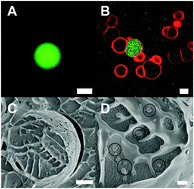Evaluation of dextran(ethylene glycol) hydrogel films for giant unilamellar lipid vesicle production and their application for the encapsulation of polymersomes†
Abstract
Giant Unilamellar Vesicles (GUVs) prepared from phospholipids are becoming popular membrane model systems for use in biophysical studies. The quality, size and yield of GUVs depend on the preparation method used to obtain them. In this study, hydrogels consisting of dextran polymers crosslinked by poly(ethylene glycol) (DexPEG) were used as hydrophilic frameworks for the preparation of vesicle suspensions under physiological ionic strength conditions. A comparative study was conducted using hydrogels with varied physicochemical properties to evaluate their performance for GUV production. The prepared GUVs were quantified by flow cytometry using the Coulter Principle to determine the yield and size distribution. We find that hydrogels of lower mechanical strength, increased swellability and decreased lipid interaction favour GUV production, while their resulting size is determined by the surface roughness of the hydrogel film. Moreover, we embedded polymersomes into the crosslinked hydrogel network, creating a DexPEG – polymersome hybrid film. The re-hydration of lipids on those hybrid substrates led to the production of GUVs and the efficient encapsulation of polymersomes in the lumen of GUVs.



 Please wait while we load your content...
Please wait while we load your content...